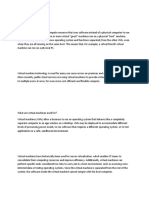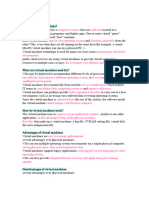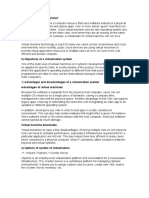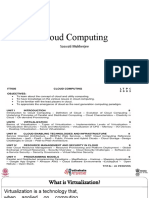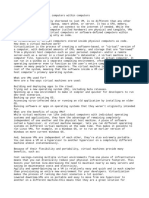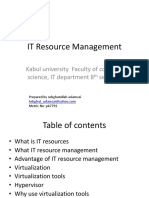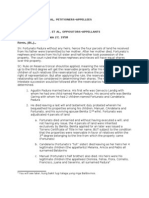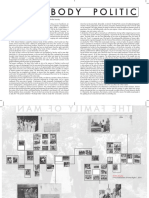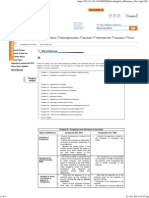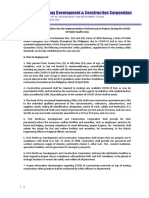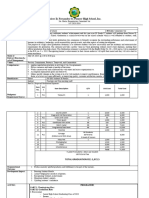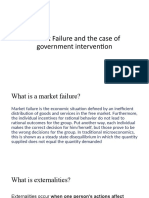What is a virtual machine?
A Virtual Machine (VM) is a compute resource that uses software instead of a physical
computer to run programs and deploy apps. One or more virtual “guest” machines run
on a physical “host” machine. Each virtual machine runs its own operating system and functions
separately from the other VMs, even when they are all running on the same host. This means that,
for example, a virtual MacOS virtual machine can run on a physical PC.
Virtual machine technology is used for many use cases across on-premises and cloud
environments. More recently, public cloud services are using virtual machines to provide virtual
application resources to multiple users at once, for even more cost efficient and flexible compute.
What are virtual machines used for?
Virtual machines (VMs) allow a business to run an operating system that behaves like a
completely separate computer in an app window on a desktop. VMs may be deployed to
accommodate different levels of processing power needs, to run software that requires a different
operating system, or to test applications in a safe, sandboxed environment.
Virtual machines have historically been used for server virtualization, which enables IT teams
to consolidate their computing resources and improve efficiency. Additionally,
virtual machines can perform specific tasks considered too risky to carry out in a host environment,
such as accessing virus-infected data or testing operating systems. Since the virtual machine
is separated from the rest of the system, the software inside the virtual machine cannot tamper with
the host computer.
How do virtual machines work?
The virtual machine runs as a process in an application window, similar to any other
application, on the operating system of the physical machine. Key files that make up a virtual
machine include a log file, NVRAM setting file, virtual disk file and configuration file.
Advantages of virtual machines
Virtual machines are easy to manage and maintain, and they offer several advantages over physical
machines:
VMs can run multiple operating system environments on a single physical
computer, saving physical space, time and management costs.
Virtual machines support legacy applications, reducing the cost
of migrating to a new operating system. For example, a Linux virtual
machine running a distribution of Linux as the guest operating system can
exist on a host server that is running a non-Linux operating system, such as
Windows.
VMs can also provide integrated disaster recovery and application
provisioning options.
Disadvantages of virtual machines
While virtual machines have several advantages over physical machines, there are also
some potential disadvantages:
Running multiple virtual machines on one physical machine can result
in unstable performance if infrastructure requirements are not met.
Virtual machines are less efficient and run slower than a full physical
computer. Most enterprises use a combination of physical and virtual
infrastructure to balance the corresponding advantages and disadvantages.
The two types of virtual machines
Users can choose from two different types of virtual machines—process VMs and system VMs:
A process virtual machine allows a single process to run as an application on a host machine,
providing a platform-independent programming environment by masking the information of the
underlying hardware or operating system. An example of a process VM is the Java Virtual
Machine, which enables any operating system to run Java applications as if they were native to
that system.
A system virtual machine is fully virtualized to substitute for a physical machine. A system
platform supports the sharing of a host computer’s physical resources between multiple virtual
machines, each running its own copy of the operating system. This virtualization process relies
on a hypervisor, which can run on bare hardware, such as VMware ESXi, or on top of an operating
system.
What are 5 types of virtualization?
All the components of a traditional data center or IT infrastructure can be virtualized today, with
various specific types of virtualization:
Hardware virtualization: When virtualizing hardware, virtual versions of
computers and operating systems (VMs) are created and consolidated into a
single, primary, physical server. A hypervisor communicates directly with a
physical server’s disk space and CPU to manage the VMs. Hardware
virtualization, which is also known as server virtualization, allows hardware
resources to be utilized more efficiently and for one machine
to simultaneously run different operating systems.
Software virtualization: Software virtualization creates a computer system
complete with hardware that allows one or more guest operating systems to
run on a physical host machine. For example, Android OS can run on a host
machine that is natively using a Microsoft Windows OS, utilizing the same
hardware as the host machine does. Additionally, applications can be
virtualized and delivered from a server to an end user’s device, such as a
laptop or smartphone. This allows employees to access centrally
hosted applications when working remotely.
Storage virtualization: Storage can be virtualized by consolidating multiple
physical storage devices to appear as a single storage device. Benefits
include increased performance and speed, load balancing and reduced costs.
Storage virtualization also helps with disaster recovery planning, as virtual
storage data can be duplicated and quickly transferred to another location,
reducing downtime.
Network virtualization: Multiple sub-networks can be created on the same
physical network by combining equipment into a single, software-
based virtual network resource. Network virtualization also divides available
bandwidth into multiple, independent channels, each of which can be
assigned to servers and devices in real time. Advantages include increased
reliability, network speed, security and better monitoring of data
usage. Network virtualization can be a good choice for companies with
a high volume of users who need access at all times.
Desktop virtualization: This common type of virtualization separates the
desktop environment from the physical device and stores a desktop on a
remote server, allowing users to access their desktops from anywhere on any
device. In addition to easy accessibility, benefits of virtual desktops
include better data security, cost savings on software licenses and
updates, and ease of management.
Container vs Virtual Machine
Like virtual machines, container technology such as Kubernetes is similar in the sense of running
isolated applications on a single platform. While virtual machines virtualize the hardware layer to
create a “computer,” containers package up just a single app along with its dependencies. Virtual
machines are often managed by a hypervisor, whereas container systems provide shared operating
system services from the underlying host and isolate the applications using virtual-memory
hardware.
A key benefit of containers is that they have less overhead compared to virtual machines.
Containers include only the binaries, libraries and other required dependencies, and the
application. Containers that are on the same host share the same operating system kernel, making
containers much smaller than virtual machines. As a result, containers boot faster, maximize server
resources, and make delivering applications easier. Containers have become popluar for use
cases such as web applications, DevOps testing, microservices and maximizing the number of apps
that can be deployed per server.
Virtual machines are larger and slower to boot than containers. They are logically isolated from
one another, with their own operating system kernel, and offer the benefits of a completely
separate operating system. Virtual machines are best for running multiple applications together,
monolithic applications, isolation between apps, and for legacy apps running on older operating
systems. Containers and virtual machines may also be used together.
